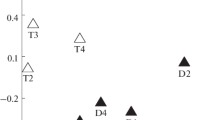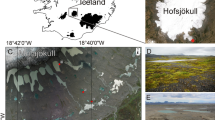Abstract—
This is the first report on investigation of bacterioplankton taxonomic composition in the Rybinsk Reservoir by molecular biological methods. A total of 58 nucleotide sequences obtained were assigned to 26 operational taxonomic units (OTUs), which belonged to Eubacteria (24 OTUs) and Eukaryota (2 OTUs). The diversity of bacterioplankton was represented by seven phyla of eubacteria: Proteobacteria, Bacteroidetes, Verrucomicrobia, Firmicutes, Actinobacteria, Gemmatimonadetes, and Acidobacteria. Predominant organisms were alphaproteobacteria of the species “Candidatus Fonsibacter ubiquis,” as well as unidentified members of the phyla Bacteroidetes and Verrucomicrobia, whose homologues are widespread in freshwater environments and have small genomes and cells. During the study period, small and medium-sized free-living cells predominated in bacterioplankton (70–99%), because they were the least vulnerable to eliminating control factors. The majority of the bacterial community was formed by cocci (50–80%), while a significant part of its biomass was accounted for by small rods (up to 2 μm in length) (20–30%).


Similar content being viewed by others
REFERENCES
Cabello-Yeves, P.J., Ghai, R., Mehrshad, M., Picazo, A., Camacho, A., and Rodriguez-Valera, F., Reconstruction of diverse verrucomicrobial genomes from metagenome datasets of freshwater reservoirs, Front Microbiol., 2017, no. 8, аrt. 2131. https://doi.org/10.3389/fmicb.2017.02131
Caron, D.A., Technique for enumeration of heterotrophic and phototrophic nanoplankton, using epifluorescence microscopy, and comparison with other procedures, Appl. Environ. Microbiol., 1983, vol. 46, no. 2, pp. 491–498.
Ciric, S., Ilic, Z., Milosevic, B., Knezevic, J., and Spasic, Z., Abundance and morphotype diversity of bacterioplankton in Celije reservoir, Serbia, Fresenius Environ. Bull., 2012, vol. 21, no. 6b, pp. 1647–1653.
Cuvelier, M., Allen, A., Monier, A., McCrow, J., Messié, M., Tringe, S., Woyke, T., Welsh, R., Ishoey, T., Lee, J.-H., Binder, B.J., Dupont, C.L., Latasa, M., Guigand, C., Buck, K.R., et al., Targeted metagenomics and ecology of globally important uncultured eukaryotic phytoplankton, Proc. Natl. Acad. Sci. U. S. A., 2010, vol. 107 (33), pp. 14679–14684.
Debroas, D., Humbert, J.-F., Enault, F., Bronner, G., Faubladier, M., and Cornillot, E., Metagenomic approach studying the taxonomic and functional diversity of the bacterial community in a mesotrophic lake (lac du Bourget— France), Environ. Microbiol., 2009, vol. 11, no. 9, pp. 2412–2424.
Denisova, L.Ya., Bel’kova, N.L., Tulokhonov, I.I., and Zaichikov, E.F., Bacterial diversity at various depths in the southern part of Lake Baikal as revealed by 16S rDNA sequencing, Microbiology (Moscow), 1999, vol. 68, no. 4, pp. 475‒483.
Fernandez-Gomez, B., Richter, M., Schüler, M., Pinhassi, J., Acinas, S.G., González J.M., and Pedrós-Alió, C., Ecology of marine Bacteroidetes: a comparative genomics approach, ISME J., 2013, vol. 7, pp. 1026–1037.
Iliev, I., Yahubyan, G., Marhova, M., Apostolova, E., Gozmanova, M., Gecheva, G., and Kostadinova, S., Metagenomic profiling of the microbial freshwater communities in two Bulgarian reservoirs, J. Basic Microbiol., 2017, no. 57, pp. 669–679.
Karayanni, H., Macingo, S.C., Tolis, V., and Alivertis, D., Diversity of bacteria in lakes with different chlorophyll content and investigation of their respiratory activity through a long-term microcosm experiment, Water, 2019, no. 11, pp. 467–482. https://doi.org/10.3390/w11030467
Kopylov, A.I. and Kosolapov, D.B., Bakterioplankton vodokhranilishch Verkhnei i Srfednei Volgi (Bacterioplankton of the Upper and Middle Volga Reservoirs), Moscow: Sovr. Gum. Univer., 2008.
Kopylov, A.I., Kosolapov, D.B., and Zabotkina, E.A., Viruses in the plankton of the Rybinsk Reservoir, Microbiology (Moscow), 2007, vol. 76, no. 6, pp. 782–790.
Krambeck, C., Krambeck, H.-J., and Overbeck, J., Microcomputer assisted biomass determination of plankton bacteria on scanning electron micrographs, Appl. Environ. Microbiol., 1981, vol. 42, no. 1, pp. 142–149.
Kuznetsova, E.V., Kosolapov, D.B., and Belkova, N.L., Diversity of Planktonic Bacteria in Durgun and Taishir Reservoirs (Western Mongolia), Microbiology (Moscow), 2020a, vol. 89, no. 5, pp. 595–602.
Kuznetsova, E.V., Kosolapov, D.B., and Kosolapova, N.G., Taxonomic and size–morphological groups of bacterioplankton in two Mongolian reservoirs, Biol. Bull., 2020b, vol. 47, no. 1, pp. 27–34.
Lindström, E.S., Investigating influential factors on bacterioplankton community composition: results from a field study of five mesotrophic lakes, Microb. Ecol., 2001, no. 42, pp. 598–605.
Mineeva, N.M. and Makarova, O.S., Chlorophyll content as indicator of the modern (2015–2016) trophic state of Volga river reservoirs, Inland Water Biol., 2018, vol. 11, no. 3, pp. 367– 370.
Neuenschwander, S.M., Ghai, R., Pernthaler, J., and Salcher, M.M., Microdiversification in genome-streamlined ubiquitous freshwater Actinobacteria, The ISME J., 2018, no. 12, pp. 185–198.
Noble, R.T. and Fuhrman, J.A., Use of SYBR Green I for rapid epifluorescence counts of marine viruses and bacteria, Aquat. Microb. Ecol., 1998, vol. 14, no. 2, pp. 113–118.
Pernthaler, J., Sattler, B., Simek, K., Schwarzenbacher, A., and Psenner, R., Top-down effects on the size-biomass distribution of a freshwater bacterioplankton community, Aquat. Microb. Ecol., 1996, vol. 10, pp. 255–263.
Polverino, D., Marinelarena, A.J., McCarthy, C.B., and Rivera-Pomar, R.V., Culture-independent characterization of the bacterioplankton community composition of a mesotrophic reservoir (Embalse Rio III, Argentina), Revista Mexicana de Biodiversidad, 2012, no. 83, pp. 548–552.
Porter, K.G. and Feig, Y.S., The use of DAPI for identifying and counting of aquatic microflora, Limnol. Oceanogr., 1980, vol. 25, no. 5, pp. 943–948.
Qu, J., Jia, C., Liu, Q., Li, Z., Liu, P., Yang, M., Zhao, M., Li, W., Zhu, H., and Zhang, Q., Dynamics of bacterial community diversity and structure in the terminal reservoir of the South-to North water diversion project in China, Water, 2018, no. 10, pp. 709–722.
Radnagurueva, A.A., Zaitsev, S.V., and Lavrent’eva, E.V., Taxonomic diversity of microbial communities of the Baikal rift zone thermal springs, Biotekhnologiya v interesakh ekonomiki i ekologii Sibiri i Dal’nego Vsotoka (Biotechnology in the Interests of Economy and Ecology of SIberia and Far East), 2016, pp. 98–100.
Romanenko, V.I., Mikrobiologicheskie protsessy produktsii i destruktsii organicheskogo veshchestva vo vnutrennikh vodoemakh (Microbial Processes of Organic Matter Production and Decomposition in Inland Basins), Leningrad: Nauka, 1985.
Romanenko, V.I., Zakharova, L.I., and Romanenko, V.A., Assessment of water quality by microbiological parameters in the Rybinsk Reservoir near Cherepovets, Vliyanie stokov Cherepovetskogo promyshlennogo uzla na ekologicheskoe sostoyanie Rybinskogo vodokhranilishcha (Effect of the Cherepovets Industrial Node Waste on the Ecological State of the Rybinsk Reservoir), 1990, pp. 24–41.
Ruiz-Gonzalez, C., Proia, L., Ferrera, I, Gasol, J.M., and Sabater, S., Effects of large river dam regulation of bacterioplankton community structure, FEMS Microbiol. Ecol., 2013, no. 84, pp. 316–331.
Rybakova, I.V., Lapteva, N.A., Sukhanova, E.V., and Bel’kova, N.L., Adapting molecular-genetic methods for studying the taxonomic diversity of microbial communities associated with macrophytes, Inland Water Biol., 2009, vol. 2, no. 1, pp. 96−103.
Sambrook, J., Fritsch, E.F., and Maniatis, T. Molecular Cloning: A Laboratory Manual, New York: Cold Spring Harbor Lab., 1989.
Schiaffino, M.R., Sanchez, M.L., Gerea, M., Unrein, F., Balague, V., Gasol, J.M., and Izaguirre, I., Distribution patterns of the abundance of major bacterial and archaeal groups in Patagonian lakes, J. Plankton Res., 2016, vol. 38, no. 1, pp. 64–82.
Simek, K., Hornak, K., Jezbera, J., Nedoma, J., Znachor, P., Hejzlar, J., and Seda, J., Spatio-temporal patterns of bacterioplankton production and community composition related to phytoplankton composition and protistan bacterivory in a dam reservoir, Aquat. Microb. Ecol. 2008, no. 51, pp. 249–262.
The Prokaryotes. A Handbook on the Biology of Bacteria / Dworkin, M., Falkow, S., Rosenberg, E., Schleifer, K.-H., and Stackebrandt, E., Eds., New York: Springer, 2006.
Tsementzi, D., Rodriguez-R, L.M., Ruiz-Perez, C.A., Meziti, A., Hatt, J.K., and Konstantinidis, K.T., Ecogenomic characterization of widespread, closely-related SAR11 clades of the freshwater genus “Candidatus Fonsibacter” and proposal of Ca. Fonsibacter lacus sp. nov., Syst. Appl. Microbiol., 2019, no. 42, pp. 495‒505.
Tsydenova B.V., Dagurova, O.P., Garankina, V.P., Dambaev, V.B., Matafonov, D.V., and Baturina, O.A., Abundance and taxonomic composition of bacterioplankton in freshwater lake Gusinoye (Buryatia) in the warm water zone of the Gusinoozerskaya thermal power plant, J. Siber. Fed. Univ. Biology., 2018, vol. 11, no. 4, pp. 356–366.
Wei, G., Li, J., Wang, N., and Gao, Z., Spatial abundance and diversity of bacterioplankton in a typical stream-forming ecosystem, Huangqian reservoir, China, J. Microbiol. Biotechnol., 2014, vol. 24, no. 10, pp. 1308–1318.
Yang, X., Huang, T., and Zhang, H., Effects of seasonal thermal stratification on the functional diversity and composition of the microbial community in a drinking water reservoir, Water, 2015, vol. 7, pp. 5525–5546.
ACKNOWLEDGMENTS
The authors are grateful to N.L. Bel’kova for her help in obtaining the results of molecular genetic analysis.
Funding
The work was carried out within the framework of the State Assignment no. АААА-А18-118012690098-5 and was supported by the Russian Foundation for Basic Research, project no. 15-34-50453 mol-nr.
Author information
Authors and Affiliations
Corresponding author
Ethics declarations
The authors declare that they have no conflict of interest. This article does not contain any studies involving animals or human participants performed by any of the authors.
Additional information
Translated by P. Sigalevich
Rights and permissions
About this article
Cite this article
Kuznetsova, E.V., Sukhanova, E.V. & Kosolapov, D.B. Taxonomic Diversity and Size-Morphological Structure of Bacterioplankton of the Rybinsk Reservoir. Microbiology 90, 324–335 (2021). https://doi.org/10.1134/S002626172103005X
Received:
Revised:
Accepted:
Published:
Issue Date:
DOI: https://doi.org/10.1134/S002626172103005X




